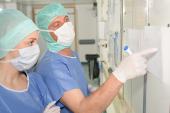Delaying Surgery After COVID-19 Cuts Risk of CV Complications
The researchers say it’s best to calculate the risks and benefits, rather than define an optimal time for surgery post-COVID.

The longer surgery is delayed following a COVID-19 diagnosis, the lower the likelihood of major postoperative cardiovascular complications, according to a new analysis of retrospective data.
While the study doesn’t pinpoint the exact mechanism at play, the findings are in line with previous recommendations to delay elective surgery by at least 7 weeks after infection.
“While there are several guidelines for timing of surgery, nearly all are based on the risk of postoperative pulmonary complications and fail to account for major cardiovascular complications,” senior author Robert Freundlich, MD (Vanderbilt University Medical Center, Nashville, TN), told TCTMD in an email. “To the best of my knowledge, all of the guidelines assign an ‘optimal’ amount of time for delaying surgery that, in my opinion, fail to take into account the often-significant risks to patients of delaying major surgery. By better understanding individual risk, I hope to better inform patients and surgeons about how to best individualize timing of surgery.”
He advises against defining any particular time for surgery as optimal. “Every patient is different, and every patient has a reason for needing surgery,” Freundlich explained. “If your surgery is purely elective and you’ve had recent COVID, this is undoubtedly worth discussing with your providers—delay may be warranted. On the other hand, if you require urgent surgery, the risks of delaying surgery will likely supersede the risks of COVID-related complications.”
Commenting on the findings for TCTMD, Nathaniel R. Smilowitz, MD (New York University School of Medicine, NY), agreed that the study is consistent with others in this space. While it’s true that there is a risk-benefit equation to be calculated when determining time to surgery for every patient, especially those that require emergent procedures, he guessed that “between 2 or 3 months seems like a reasonable time frame to delay after a diagnosis of COVID.”
Longer Delay, Better Outcomes
For the study, published online this week in JAMA Network Open, John Bryant, MD (Vanderbilt University Medical Center), Freundlich and colleagues looked at 3,997 patients (median age 51.3 years; 55.6% female) with a previous COVID-19 diagnosis via PCR testing who underwent surgery (92.6% elective; 7.4% emergent) at their institution between January 2020 and December 2021. The most common type of surgery was GI (25.1%), followed by orthopedic (14.3%) and head and neck (10.4%), while cardiac surgery was performed in 5.8%.
The median time from COVID-19 diagnosis to surgery was 98 days, with just over one-third of patients (34.9%) undergoing surgery within 7 weeks. In total, 12.1% of patients reported major postoperative cardiovascular events (primary composite outcome), with the most common comorbid events being acute kidney injury (9.1%), myocardial injury (2.9%), and deep vein thrombosis (1.5%). At 30 days, 2.0% of patients had died.
If your surgery is purely elective and you’ve had recent COVID, this is undoubtedly worth discussing with your providers—delay may be warranted. Robert Freundlich
On multivariate analysis, increased time from COVID-19 diagnosis to surgery was associated with a decreased rate of the primary composite outcome (adjusted OR 0.99 per 10 days; 95% CI 0.98-1.00). On the other hand, older age, male sex, Black or African American race, higher American Society of Anesthesiologists (ASA) classification, ASA emergency status, and those undergoing urologic procedures were more likely to report a primary outcome event. Eight Elixhauser comorbidities—cardiac arrhythmias, neurodegenerative disorders, kidney failure, lymphoma, solid tumor, coagulopathy, weight loss, and fluid and electrolyte disorders—also were associated with higher risk.
Sensitivity analyses looking at patients who had received at least one dose of the COVID-19 vaccine and those with postoperative pulmonary complications, accounting for COVID-19 symptom severity, and excluding the patients who died all confirmed the main study findings.
Freundlich said while the overall results weren’t unexpected, he was “particularly surprised by the magnitude of the relationship, as well as the duration of the relationship. While we cannot say that the time interval unequivocally caused the relationship, the magnitude of the relationship is such that this is worth exploring in additional studies.”
He especially would like to see other institutions around the globe perform similar analyses.
Applicability, Future Research
It is not clear why a prior SARS-CoV-2 infection would lead to worse surgical outcomes, but Smilowitz explained that COVID-19 is associated with diffuse endotheliopathy. “So, it is possible that that is affecting multiple organ systems, but we do not really understand [what’s happening],” he said, highlighting that the event rates in this study were driven by renal outcomes.
Smilowitz criticized some definitions used by the researchers, including what constituted cerebrovascular accident. “They required a performing stroke specific imaging and a neurology consultation, but they did not . . . do chart review to confirm the diagnosis of stroke. So some of the diagnoses could have been adjudicated more stringently,” he specified.
Also, because the study was conducted during the height of the initial COVID-19 wave, the findings might not be as applicable today when there’s widespread immunity as well as changing variants. “It is unclear how we apply these historical findings to contemporary practice given the changing landscape in COVID,” Smilowitz said.
He would also like to see other institutions perform similar analyses. “I think randomized trials of timing of surgery are probably not realistic, but certainly that could be done in a motivated health system—allowing some people to go to surgery earlier and mandating a delay for others,” Smilowitz said. “But otherwise, just contemporary observational data will be helpful to see whether the association between timing and outcomes is consistent in the current era.”
Yael L. Maxwell is Senior Medical Journalist for TCTMD and Section Editor of TCTMD's Fellows Forum. She served as the inaugural…
Read Full BioSources
Bryant JM, Boncyk CS, Rengel KF, et al. Association of time to surgery after COVID-19 infection with risk of postoperative cardiovascular morbidity. JAMA Netw Open. 2022;5(12):e2246922.
Disclosures
- Freundlich reports receiving funding from National Heart, Lung, and Blood Institute and the National Institutes of Health/National Center for Advancing Translational Sciences.
- Bryant reports no relevant conflicts of interest.
- Smilowitz reports a financial relationship with Abbott Vascular.





Comments